| Aboriginal Oklahoma |
| First Known Inhabitants. —The first known inhabitants of Oklahoma were American Indians. Several different tribes claimed dominion over parts of the state when the white man first came to explore it. Of these, the Osages were found in the northern and northeastern parts of the State. The Caddoes ranged over the southeastern part of the state, in the valley of the Red River. The Wichitas lived west of the Caddoes, in the region of the Wichita Mountains. The Utes occupied the upper Cimarron country, in the northwestern part of the state. Several other tribes ranged over the present borders of Oklahoma at times, and still others that were given to roving from place to place became residents in Oklahoma a part of the time long before the white man came to make settlement within its bounds. |
| Food.—The Indians of the Caddo and Wichita tribes generally lived in settled villages and cultivated the soil. The crops grown by them included corn, beans, pumpkins, melons, and tobacco. The Osages also cultivated small patches of corn and vegetables, but were more given to roving than the others. All of these tribes depended upon the chase for part of their food. Their country abounded in game of all kinds, including the buffalo, elk. deer, antelope, opossum, raccoon, rabbit, hare, wild turkey, grouse and other animals and birds. To the Indians of all these tribes as well as to those of the roving tribes of the Plains who afterward came to live in Oklahoma, the buffalo was a most important animal. Its flesh was used for food; from the skins, clothes, moccasins, robes, ropes and tent or lodge covers were made; awls and needles were made of bone; the stomach and entrails were used as vessels for carrying water, especially on the march, in the dry, treeless region. The Indians were skilled hunters, a stone-pointed arrow sometimes being shot from a bow entirely through the body of the buffalo. When a buffalo was killed the hide was cut open at the breast and pulled off at the joints, the Indians using a small flint knife, about as big as the finger, apparently with as much ease as if working with a modern steel-bladed knife. The flesh of the buffalo was cooked over the fire. The liver and the lining of the stomach were frequently eaten raw at the time the animal was killed. The meat of the buffalo, elk, deer, and antelope was preserved for future use by cutting or jerking into thin strips and drying in the sun. |
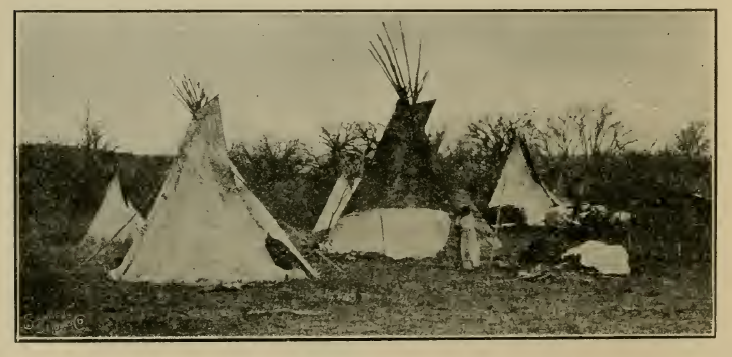 |
| LONE WOLF’S VILLAGE (KIOWA), BUFFALO SKIN LODGES, (From Photograph Made in 1872) |
| Shelter. —The Comanches, Kiowas and other Indians of the Plains lived in lodges or tepees, which were made by using a framework of poles drawn together at the top like a tripod and covered with buffalo skins. The Caddoes and Wichitas used similar lodges when on their hunting or visiting excursions, but in their settled villages they had large dome-shaped huts, the framework of which consisted of posts and poles, covered and bound firmly together with withes and brush and the whole neatly thatched with coarse grass. These grass houses, as they are called, are still in use by the Wichitas and Caddoes, who live in Caddo County, Oklahoma. In addition to the ordinary tepee, the Osages and kindred tribes built lodges by setting poles in the ground and bending and binding them together in such a way as to form a frame with a rounded top, which was then covered with skins or bark. In moving a village or encampment of buffalo skin lodges from one place to another, the skins were first taken from the pole framework and rolled and tied in bundles. The ends of two lodge poles were then fastened to the collar of a dog (one on either side) with the ends trailing on the ground. A small package of robes, skins, dried meat or other belongings would then be fastened to the two poles behind the dog. Thus, in reality, that poor brute became a beast of burden and a most useful one, too. These dogs were the only domestic animals which the Indians owned until the coining of the white settlers made it possible for them to obtain horses. Their dogs were half-wild and, like the Eskimo dog, bore a strong resemblance to the wolf. |
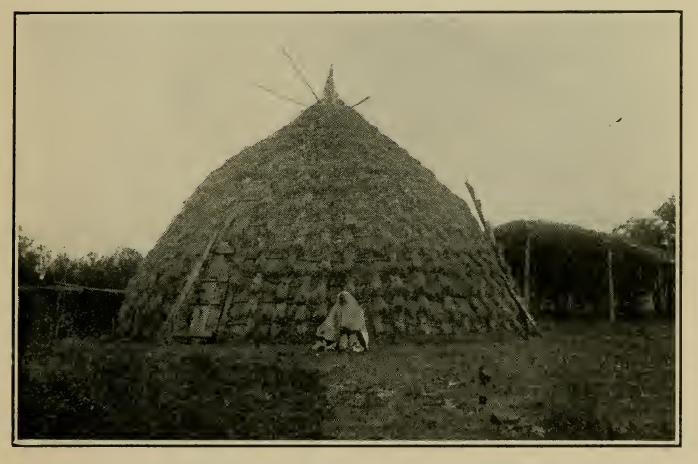 |
| GRASS-THATCHED HOUSE OF THE WICHITA INDIANS |
| - |
| Products. —In the preparation of the soil, planting seed and attending to the crops, rude hoes and spades were used. These were made of the shoulder blades of buffalo or other large animals and mounted on wooden handles. Men as well as women worked in the fields and gardens, among the Caddoes and Wichitas. Among the Osages, who paid much less attention to agriculture, the work of planting and tending corn and vegetables was left to the women. The Caddoes are said to have been the only native tribe that made pottery and baskets. |
| Weapons of War and the Chase. —In the chase the Indian hunters used the bow and arrow or the lance. In war they used these weapons and war clubs and stone hatchets as well, with shields or bucklers (made of the thickest part of the skin of an old buffalo), which were used for protection. The various tribes were often at war with each other. Indeed, if one is to judge from the fact that practically all of the men of each tribe were known as warriors, it would seem that war must have been their chief business of life. |
| The Coming of the Horse and its Effects. —Between the time the Spaniards began to explore the region of which Oklahoma is a part, and the first appearance of French in the valleys of the Arkansas and Red rivers, the Indians of this region had secured horses, probably from the Spanish settlements in the valley of the Rio Grande. This resulted in a great change in the habits and disposition of the Indians. It greatly widened their field of operations and made possible marauding forays into regions and at distances hitherto out of reach. The buffalo herds were easier to find. The animals were killed with less exertion and the moving of surplus meat and skins and of larger lodges or tepees became a matter of much less moment. In time the Indians grew accustomed to estimating their wealth by the number of ponies owned. As the Indians of a given tribe thus roamed over a greater range of territory their opportunities and temptations to become embroiled in wars increased. Indeed, horse stealing as well as scalp hunting became one of their ruling passions. The constant warring o f these tribes probably is accountable for the sparseness of the population of such a great area, though disease, especially smallpox, may have had much to do with preventing its increase. |
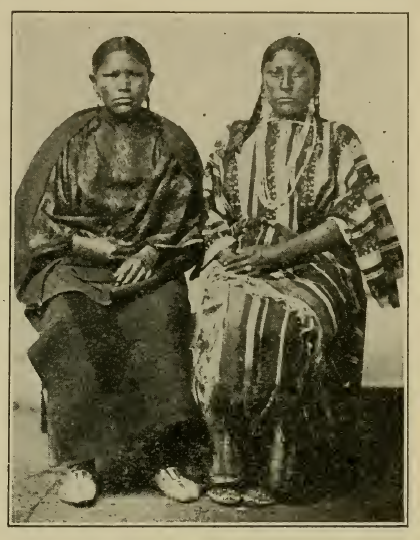 Physical Development and Disposition. —The warriors of some of the tribes of the Great Plains exhibited a less perfect muscular development than those of the tribes of the mountains and timbered regions. Their limbs were small and not well shaped, apparently having more sinew than muscle. This probably was caused by their almost constant use of the saddle. They wore their hair long, the scalp lock (i. e., a small portion of the hair growing on the crown of the head) being neatly plaited. The women were usually of short stature, but much nearer perfection in their muscular development. The popular conception is that Indian women were almost uniformly treated as a lower order of beings, fit only to be the drudges and servants of the warriors; that they performed all of the labor such as cooking, sewing, dressing and tanning the skins of animals, carrying wood and water, taking down, packing and setting up the tepees when the village was moved, herding the ponies and even saddling them at the behest of the head of the family, and that the men seldom exerted themselves except to hunt or to make war on their enemies. As a matter of fact, the Indian woman ruled her own household, had much leisure for amusement and was thoroughly contented with her lot. Physical Development and Disposition. —The warriors of some of the tribes of the Great Plains exhibited a less perfect muscular development than those of the tribes of the mountains and timbered regions. Their limbs were small and not well shaped, apparently having more sinew than muscle. This probably was caused by their almost constant use of the saddle. They wore their hair long, the scalp lock (i. e., a small portion of the hair growing on the crown of the head) being neatly plaited. The women were usually of short stature, but much nearer perfection in their muscular development. The popular conception is that Indian women were almost uniformly treated as a lower order of beings, fit only to be the drudges and servants of the warriors; that they performed all of the labor such as cooking, sewing, dressing and tanning the skins of animals, carrying wood and water, taking down, packing and setting up the tepees when the village was moved, herding the ponies and even saddling them at the behest of the head of the family, and that the men seldom exerted themselves except to hunt or to make war on their enemies. As a matter of fact, the Indian woman ruled her own household, had much leisure for amusement and was thoroughly contented with her lot. |
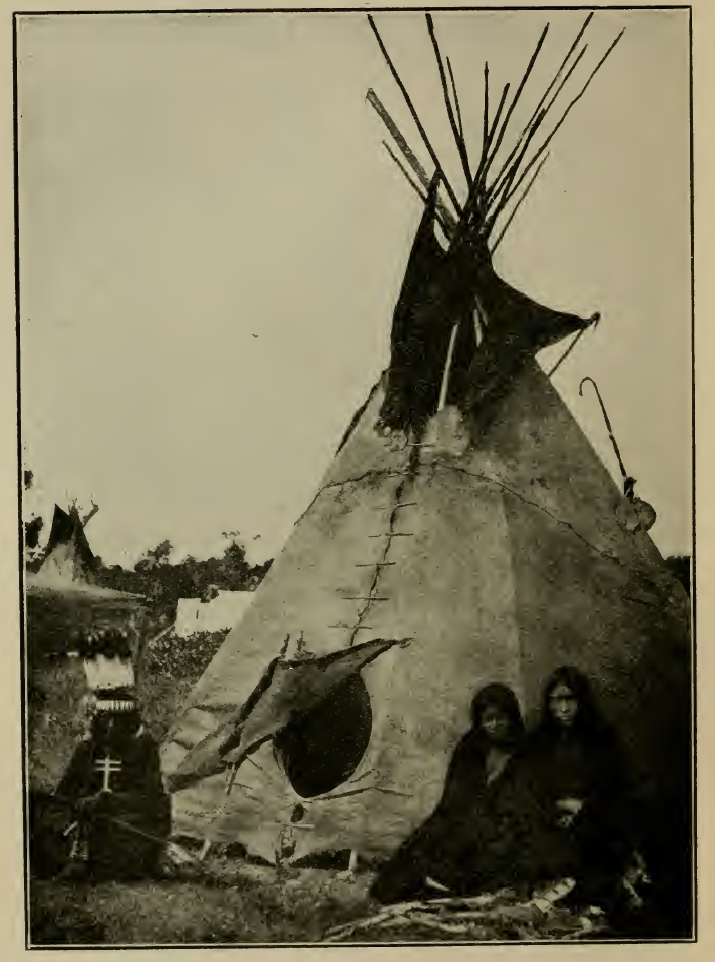 |
| BUFFALO SKIN LODGE OR TEPEE (CHEYENNE) (From Photo Made in 1872) |
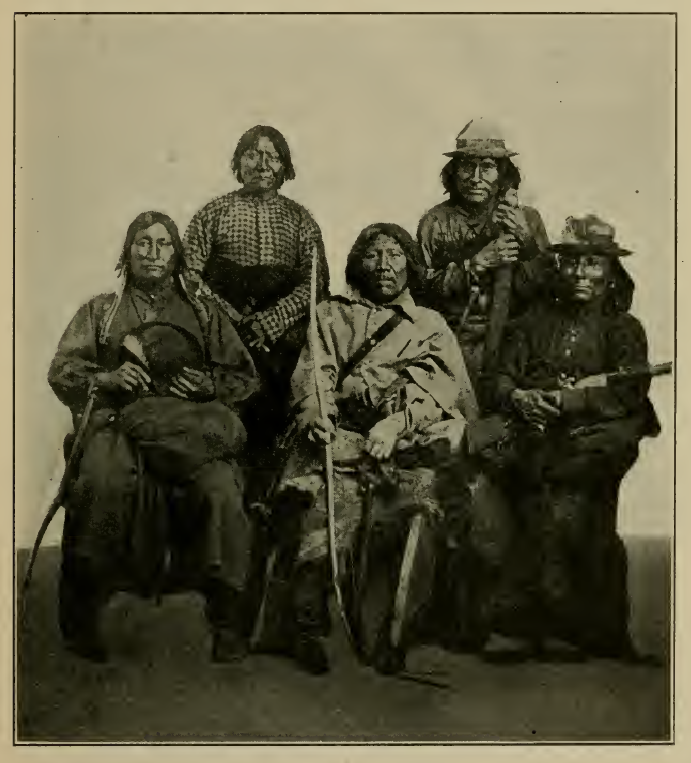 |
| KIOWA WARRIORS, 1872 |
| As a rule, the warriors were insolent, vain and boastful, often lacking in both moral and physical courage, crafty, cruel and blood-thirsty, though instances of bravery and generosity were frequent. The women were very industrious, devoted and ingenuous. Generally they were of a timid disposition. Beauty was not common among them but winsome faces were by no means infrequent. Their hands and feet were well formed and the latter appeared most shapely indeed when encased in neat-fitting moccasins. |
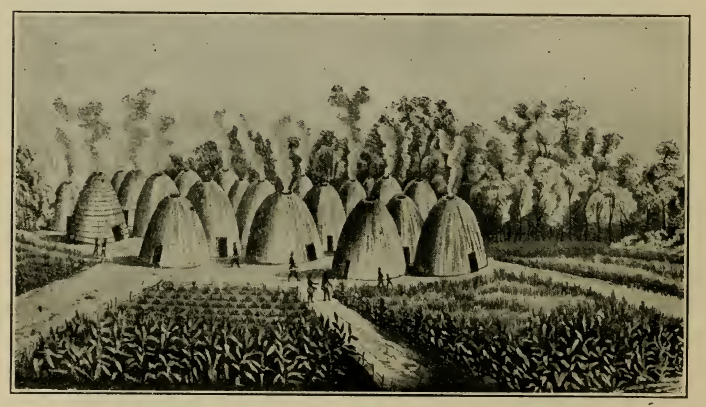 |
| WICHITA INDIAN VILLAGE AT RUSH SPRINGS IN 1852 (After Marcy) |
| Dress. —The summer attire of the warriors of the Plains tribes included only a breech-clout, moccasins and leggins. In winter they wore a buffalo robe (with the fur inside), which was wrapped around the body and covered the head. The summer costume of the women included a buck-skin skirt, moccasins and leggins, to which a buffalo robe was added in winter. Infants were carried inside the robe on the mother’s back. |
| Adornment. —The Indians were fond of adornment. Their ornaments, though crudely fashioned, were generally picturesque and sometimes artistic. In their aboriginal state they used feathers, porcupine quills and shells; the teeth and claws of animals were also largely employed. After the beginning of their intercourse with the white traders they used ornaments of glass, copper, bronze and silver. They were fond of bright colors and understood the art of extracting pigments from minerals and herbs. On state occasions, such as councils, dances, funerals, and when making war, they painted their faces and bodies with fantastic designs. The Wichitas also practiced the art of tattooing their faces. |
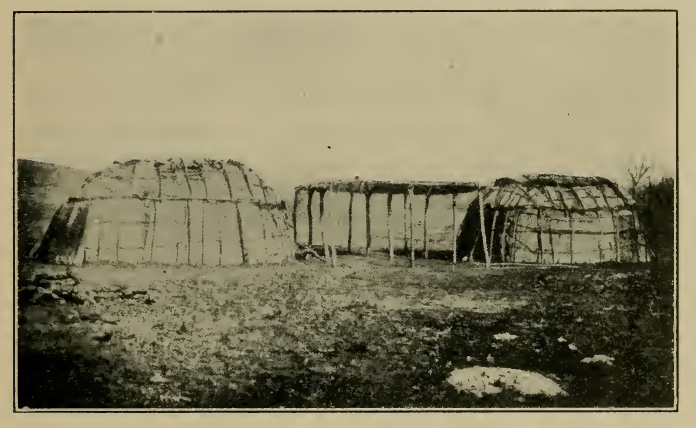 |
| BARK COVERED LODGES |
| Language. —Each tribe had its own dialect, though different tribes of the same linguistic stock had many words in common. Some of the Indian languages were rich in words, but many of the Indians were accustomed to express much thought in few words. Each language had its own peculiarities of grammatical construction. The Indians were much given to the arts of oratory and story telling. Members of separate tribes having not a single word in common could readily carry on a conversation by means of the graceful and expressive sign language which was in vogue throughout the Great Plains region from the Rio Grande to, and even beyond, the Canadian boundary. |
| Tribes and Bands. —The subdivision of tribes into bands was largely a matter of personal choice with the individuals. There were only occasional marriages between members of different tribes. Prisoners who were not tortured or killed were adopted and absorbed into the tribe. The nominal ruler of a band was the chief, though the real power was vested in the council of elders and headmen, which sat as the sole arbiter in most matters of policy. The authority of the chiefs was usually that of persuasive influence rather than absolute power. The position of chief was generally, though not always, elective. Some of the tribes had both civil chiefs and war chiefs. |
| Crimes and Punishments. —Most crimes had penalties that could be met or satisfied by the payment of a price, which, within the historic period, was usually payable in ponies. Murder was usually punished by death, a relative or friend of the victim acting as executioner. |
| Traditions. —Tribal history in the form of myths and traditions was carefully preserved and recited from time to time. Many of the tribes had crude systems of picture writing by means of which great events in tribal history were recorded upon tanned buffalo or deer skins. |
| Religion.— The Indians of all the tribes of the Southwest believed in the Good Spirit or “Master of Life” and in an Evil Spirit. They believed also in a future state of life and professed to be able to see God in many forms of nature. They called the sun their “father” whence came all light, and the earth their “mother” from whom came all the provisions to supply the wants and necessities of their bodies. Their “medicine men,” so-called, were in reality priests and sorcerers, and what they termed “medicine” meant mystery, sorcery, or supernatural manifestations, as well as prepared herbs. Naturally superstitious, they were easily led and influenced by the audacious claims and mysterious incantations of the “medicine man.” |


 Physical Development and Disposition. —The warriors of some of the tribes of the Great Plains exhibited a less perfect muscular development than those of the tribes of the mountains and timbered regions. Their limbs were small and not well shaped, apparently having more sinew than muscle. This probably was caused by their almost constant use of the saddle. They wore their hair long, the scalp lock (i. e., a small portion of the hair growing on the crown of the head) being neatly plaited. The women were usually of short stature, but much nearer perfection in their muscular development. The popular conception is that Indian women were almost uniformly treated as a lower order of beings, fit only to be the drudges and servants of the warriors; that they performed all of the labor such as cooking, sewing, dressing and tanning the skins of animals, carrying wood and water, taking down, packing and setting up the tepees when the village was moved, herding the ponies and even saddling them at the behest of the head of the family, and that the men seldom exerted themselves except to hunt or to make war on their enemies. As a matter of fact, the Indian woman ruled her own household, had much leisure for amusement and was thoroughly contented with her lot.
Physical Development and Disposition. —The warriors of some of the tribes of the Great Plains exhibited a less perfect muscular development than those of the tribes of the mountains and timbered regions. Their limbs were small and not well shaped, apparently having more sinew than muscle. This probably was caused by their almost constant use of the saddle. They wore their hair long, the scalp lock (i. e., a small portion of the hair growing on the crown of the head) being neatly plaited. The women were usually of short stature, but much nearer perfection in their muscular development. The popular conception is that Indian women were almost uniformly treated as a lower order of beings, fit only to be the drudges and servants of the warriors; that they performed all of the labor such as cooking, sewing, dressing and tanning the skins of animals, carrying wood and water, taking down, packing and setting up the tepees when the village was moved, herding the ponies and even saddling them at the behest of the head of the family, and that the men seldom exerted themselves except to hunt or to make war on their enemies. As a matter of fact, the Indian woman ruled her own household, had much leisure for amusement and was thoroughly contented with her lot.


